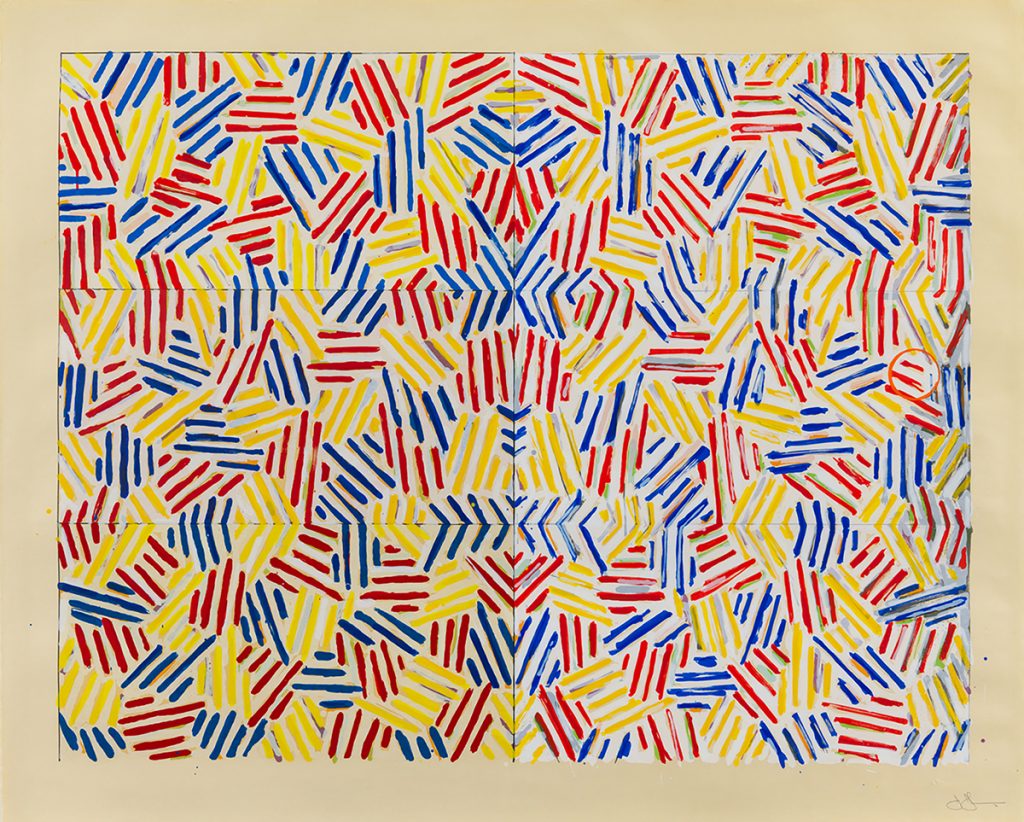

Though critical opinion sometimes found fault with his work, Johns always remained popular among collectors, with high auction prices such as: $17.05 million for "False Start" (1959) in 1988 $28.6 million for "Flag" (1960-66) in 2010 and $36 million for "Flag" (1983) in 2014. Johns's art has been displayed around the globe in 1988, he was awarded the Grand Prize at the Venice Biennale. He also collaborated with figures such as Andy Warhol and the writer Samuel Beckett (Johns produced prints to accompany Beckett's "Fizzles" text). Besides painting, he has worked in sculpture, drawing and printmaking. In his art, Johns doesn't try to convey a specific message instead, he prefers that his audience interpret his work and find its meaning themselves. As he grew older, Johns also began to include some autobiographical touches in his work. He would return to a more figurative style "Cicada" (1979) features cross-hatching and a cicada. In the 1970s, Johns shifted into abstraction, using cross-hatched patterns in numerous works. This work disrupted the dominance of Abstract Expressionism, and is credited with helping to set the stage for Pop Art and Minimalism.
#JASPER JOHNS SERIES#
For example, the lithographic stones and plates that Johns used to print Color Numerals had been reworked from those used to produce Black Numerals, a series made the previous year at Gemini."Flag" was just one example of Johns presenting a commonly seen object in a new way in addition to flags, he would produce images of targets, numbers, letters and maps. Johns has taken advantage of the opportunity offered by printmaking to test multiple options, and pursue different avenues of exploration in his repetitive, measured transformation of the numerical subject. His exploration of numeric figures began in 1955 and grew in intensity until about 1970 it is the motif to which he has returned most often, exploring it in paintings, drawings, sculpture, and prints.
#JASPER JOHNS SERIAL#
Do something else to it”- reveal the overarching serial logic of his creative approach. Jasper Johns (born May 15, 1930) is an American painter, sculptor, and printmaker whose work is associated with abstract expressionism, Neo-Dada, and pop art.

Johns’s basic instructions to himself, penned in a sketchbook-“Take an object. To say that Jasper Johns is ambivalent about having to discuss the intentions or meanings behind his art would imply that there is some part of it he doesn. Johns’s series draws renewed attention to the fact that counting, something the mind already knows but overlooks, involves eye, mind, and body. The subject of Johns’s series, therefore, is the 10 base digits of the decimal system, derived centuries ago from humans’ 10 fingers. There is the Jasper Johns who spoke in the 1970s about wanting to sell a painting for 1 million, a figure then unheard-of for a living artist (in 2014, a flag painting sold for 36 million at a. While Johns’s numerical sequence could in theory extend indefinitely, Color Numerals demarcates a terminal arithmetic progression, its finality reinforced by the heavy white outline of Figure 9. This succession is color-coded by Johns’s signatures, which match the topmost hue in each print.

Seen in sequence, each print functions as a point on a continuum, with color transitioning from primary colors (red, yellow, and blue) in Figure 0 to secondary colors (orange, green, and purple) in Figure 9. The meaning of any series is to be found not just in its individual parts, but also in the spaces between them. This is wittily underscored by the Mona Lisa (printed in reverse) in Figure 7, a pun on the multiple definitions of “figure.” Counteracting over-familiarity, each of the Color Numerals prints elevates a number, its form derived from a commercial stencil, to a striking, rainbow-hued portrait. Johns favors subjects that “the mind already knows” but overlooks due to constant exposure.

Since the mid-1950s, Jasper Johns (American, born 1930) has reworked key motifs-flags, targets, maps, the alphabet, and numbers-in a serial fashion, exploring the impact of changes in color, scale, sequence, and medium.


 0 kommentar(er)
0 kommentar(er)
